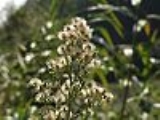
Conyza sumatrensis
Encyclopedia
Conyza sumatrensis is an annual herb
native to North America
but naturalised worldwide.
In certain countries the plant has started to exhibit resistance to herbicides.
In Britain, of the alien British Conyza
species, this is the second most abundant (after C. canadensis
) and is typically found in London and the South East of England.
It was first recorded in London by Brian Wurzell in 1984,
and noted in France at Saint-Sozy
(Dordogne) in 2006.
Herb
Except in botanical usage, an herb is "any plant with leaves, seeds, or flowers used for flavoring, food, medicine, or perfume" or "a part of such a plant as used in cooking"...
native to North America
North America
North America is a continent wholly within the Northern Hemisphere and almost wholly within the Western Hemisphere. It is also considered a northern subcontinent of the Americas...
but naturalised worldwide.
In certain countries the plant has started to exhibit resistance to herbicides.
In Britain, of the alien British Conyza
Conyza
Conyza is a genus of about 50 species of flowering plants in the family Asteraceae, native to tropical and warm temperate regions throughout the world, and also north into cool temperate regions in North America and eastern Asia...
species, this is the second most abundant (after C. canadensis
Conyza canadensis
Conyza canadensis is an annual plant native throughout most of North America and Central America. Common names include Horseweed, Canadian Horseweed, Canadian Fleabane, Coltstail, Marestail and Butterweed.It is an annual plant growing to 1.5 m tall, with sparsely hairy stems...
) and is typically found in London and the South East of England.
It was first recorded in London by Brian Wurzell in 1984,
and noted in France at Saint-Sozy
Saint-Sozy
Saint-Sozy is a commune in the Lot department in south-western France.The town is known for its production of foie gras , nuts, and tobacco....
(Dordogne) in 2006.
Plant Details
| Type | Details | Comments |
|---|---|---|
| Scientific Name | Conyza sumatrensis | Synonyms: Conyza albida, Conyza altissima, Conyza nandina |
| Common Names | fleabane, tall fleabane, broad-leaved fleabane, white horseweed, Sumatran fleabane, Guernsey fleabane | |
| Family | Asteraceae | |
| Seasonality | Annual | |
| Height | 1-2 metres when fully grown (summer/autumn) | |
| Description | Flowers are white rather than purple-pink. Its leaves are like dandelion leaves, but longer, thinner and more like primrose leaves in colour and texture. Its seeding heads are like dandelions, but straw coloured and smaller. | |
| Toxicity | ||
| Threat to other plants | It poses a significant threat to wildlife conservation areas and other reserves. Its invasive nature and competitive ability could suppress the native flora in the more open habitats it favours. | |
| Origin | North America | |
| Naturalised | South America Europe Africa Asia Australasia |

